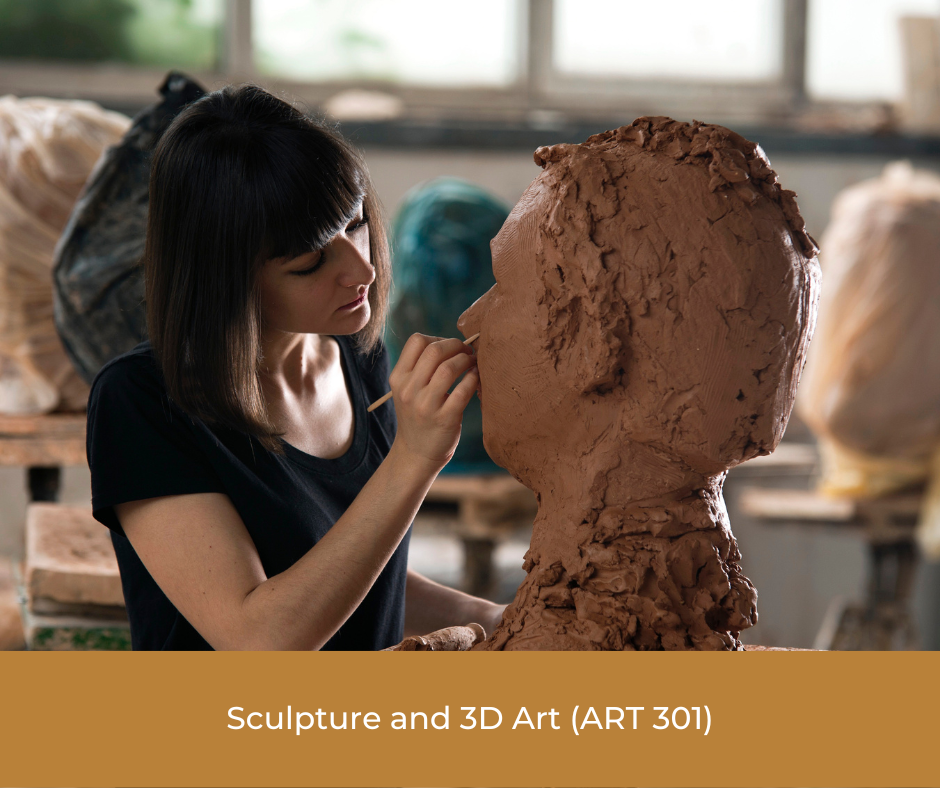Your cart is currently empty!
Sculpture and 3D Art (ART 301)

Course Description
Sculpture and 3D Art (ART 301) is an advanced course that delves into the principles and techniques of sculpture and three-dimensional art. Throughout the course, students will engage with a diverse array of materials, including clay, wood, metal, and found objects, to create sculptures that convey meaning and form. This course encourages students to explore the spatial and tactile dimensions of art while honing their creative and technical skills in sculpture.
Outline of Major Content Areas
- Introduction to Sculpture: An overview of the history and significance of sculpture as an art form. Introduction to key concepts and terminology.
- Sculptural Techniques: Exploration of various sculptural techniques, including additive and subtractive methods, modeling, carving, and assemblage.
- Materials and Tools: Familiarization with a wide range of sculpting materials and tools, such as clay, wood, metal, found objects, chisels, and welding equipment.
- Three-Dimensional Composition: Study of principles governing the composition of three-dimensional artworks. Emphasis on spatial relationships, balance, and form.
- Conceptual Sculpture: Encouragement of students to explore conceptual and abstract approaches to sculpture, expressing ideas and themes through three-dimensional form.
- Figurative Sculpture: Introduction to figurative sculpture, including the human figure and other subjects. Emphasis on anatomy, proportion, and expressive qualities.
- Installation Art: Exploration of installation art, which involves creating immersive and site-specific artworks. Students engage with the environment as part of their creative process.
- Contemporary Trends: Survey of contemporary sculpture and 3D art practices. Examination of influential sculptors and artists pushing the boundaries of the medium.
Course Learning Outcomes
Upon successful completion of Sculpture and 3D Art (ART 301), students will:
- Sculptural Proficiency: Demonstrate proficiency in using various sculptural techniques and materials to create three-dimensional artworks.
- Spatial Understanding: Exhibit a deep understanding of spatial relationships, balance, and form in the context of sculpture.
- Creative Expression: Develop the ability to express ideas, emotions, and themes through three-dimensional art, including abstract and conceptual approaches.
- Figurative Mastery: If applicable, achieve competence in figurative sculpture, including accurate representation of the human figure.
- Installation Art Skills: Gain experience in conceptualizing and creating installation art pieces that interact with their environment.
- Contemporary Awareness: Exhibit knowledge of contemporary trends and influential artists in the field of sculpture and three-dimensional art.
Methods for Assessing Student Learning
Assessment in Sculpture and 3D Art (ART 301) is designed to evaluate students’ technical skills, creative expression, and conceptual understanding. Assessment methods include:
- Sculpture Projects: Students will complete a series of sculpture projects that explore various techniques, styles, and concepts.
- Critiques: Regular critiques, facilitated by peers and the instructor, offer constructive feedback on the artistic and technical aspects of students’ sculptures.
- Three-Dimensional Composition Assignments: Assignments related to the principles of three-dimensional composition, challenging students to apply these concepts in their work.
- Conceptual Sculpture Presentation: Students may present their conceptual and abstract sculptures, explaining the ideas and themes behind their creations.
- Figurative Sculpture Assessment: If applicable, assessment of figurative sculptures will include accuracy in representation and expressive qualities.
- Installation Art Project: Evaluation of students’ ability to conceive and execute site-specific installation art pieces.
Sculpture and 3D Art (ART 301) empowers students to explore the multidimensional world of sculpture, from traditional techniques to innovative and conceptual approaches, fostering their growth as skilled and expressive sculptors.